Recognizing Moose Habitat
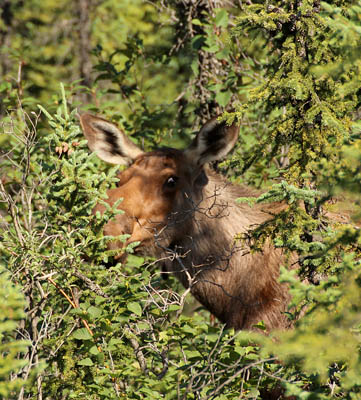
Recognizing Moose Habitat
After
months of preparation we are on our way to Alaska to look at tracks. Moose habitat and behavior were high on our list of species we hoped to encounter. We just spent 39 hours straight driving through Canada and are close to
the Alaskan border. The last three hours
were filled with a dirt road containing potholes the size of minivans and a
late night broadcasting of the World Invitational Moose Calling
Championship. We finally stop to rest,
only to be woken three hours later by a passing motorist. I crawl out of the tent completely exhausted
and when I could finally focus I was greeted with a bull moose in the middle of
the lake beside the road. He was magnificent, and he was
eating something under the water…
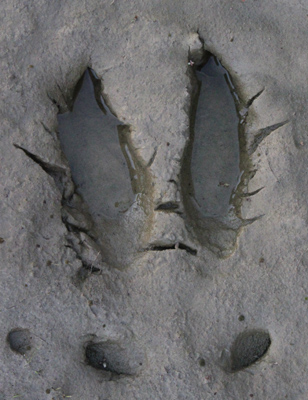
Description:
Their
great size, long legs, short neck and palmate antlers distinguish moose from other cervids. Long legs allow
adult moose to handle snow depths of 36 inches. Muscular
shoulders make the moose appear humped and they have a characteristic
"bell" of skin known as the dewlap which hands from their neck. Moose are sexually dimorphic, bulls weigh
between 850-1200 pounds and the smaller female (cow) weighs around 600-800 lbs. Moose have a total height of 8-10 feet.
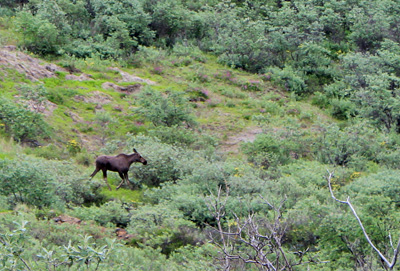
Moose Habitat:
Moose
are typically associated with boreal forests throughout Northern Asia, Northern
Europe and North America. Boreal forests
consist of pines, spruces and larch trees.
Moose habitat also includes open tundra where conifers such as dwarf birch, alder
and willows grow surrounded by lakes, bogs and streams. Moose prefer regions
where the average annual temperature is not above 60 degrees Fahrenheit.
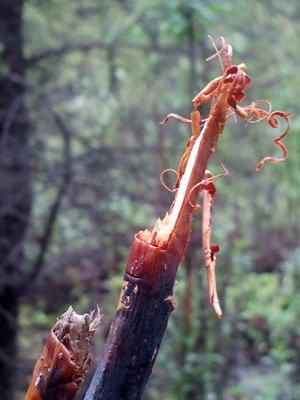
Diet:
The
word 'moose' comes from an Algonquin Indian language and means 'twig-eater'.
Moose
are browsers rather than grazers.
Because they lack upper incisors the browse is raggedly torn. Moose feed on leaves, twigs, buds, and bark
of willow, balsam, aspen, dogwood, birch, cherry, maple and viburnum and
aquatic plants such as lilies, rushes, arrowheads, and aquatic sedges. They will wade, swim and even dive to depths
of up to 15’ to reach these aquatic plants.
Be More Prepared For Your Next Outdoor Adventure!

Don't leave without knowing these six essential survival skills. Our free survival mini guide reveals the strategies of:
- Shelter & fire to prevent the number one cause of death
- Obtaining clean water to avoid life-threatening dehydration
- Common wild survival foods and other critical skills!

Tracks
My first trailing experience in moose habitat happened this spring in North Central Washington. We were traversing old logging roads looking for fresh bear sign when we came across a female moose in the road. She took off down an embankment into the forest and we spent the next 8 hours trying to catch up to her…
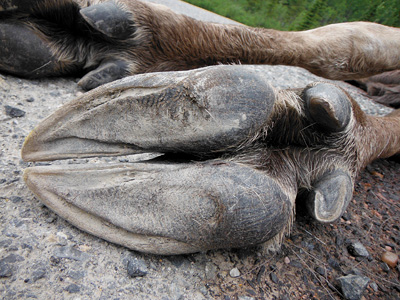
Front Tracks: 4 3/8 – 7 inches in length x 3 3/4 – 6 inches in width
- 4 toes, two of which are dew claws, raised up on the backside of the leg
- Dew claws on front feet splay out to the sides
- Hooves are heart shaped
- Front track are larger than rear tracks
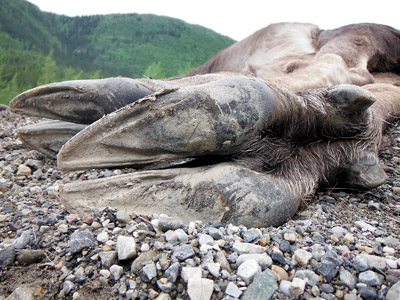
Hind Tracks: 4 1/8 – 6 ½ inches in length x 3 ½ -4 5/8 inches in width
-
4
toes, two of which are dew claws, raised up on the backside of the leg
- Dew claws point in the direction of travel and are farther back in the tracks than front foot dewclaws
- Hooves are heart shaped
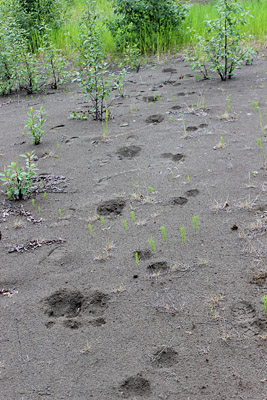
Trail:
The
trailing was going slowly. I have to climb up and over downed logs and branches
and she just walks right over them like they are twigs on the forest floor. Will I ever catch up to her?
Walk Stride: 28-44 inches. Trail Width 8 ½ -20 inches.
Trot Stride: up to 55 inches. Straddle Trot Stride 52-72 inches.
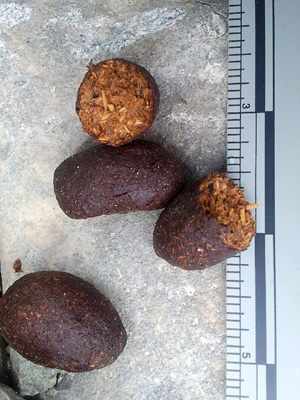
Sign:
Scat:
After
being pelted by moose scat all day Vita says, “This is addicting! I can’t believe I didn’t figure this out
sooner!” Moose scat has the perfect
size, shape and content to be the perfect throwing object.
Concentrations of scat are also good indicators of well-used moose habitat.
Pellets ½-7/8 inches diameter and 7/8-1 3/4 inches in length.
Patties are often a result of feeding on wetland vegetation.
Wallows:
Cleared depressions in the ground 4’ wide, 4’ long, 3-4” deep: dug during the
fall, in which the bull moose urinates and rolls.
Cows also roll in wallows.
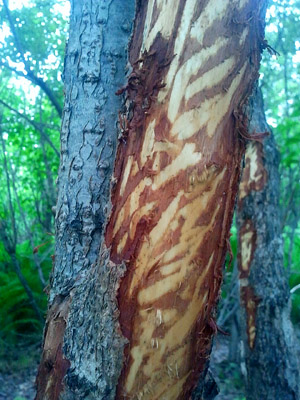
Incisor
markings: Male and female Moose scrape tree bark for territory marking and to eat
the nutritious cambium layer. These marks are commonly found on smooth barked trees in moose habitat.
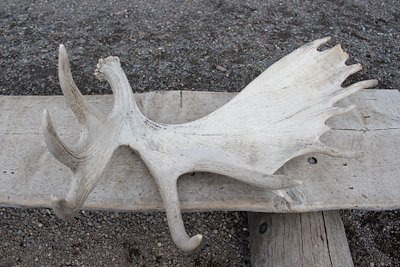
Antlers size indicates the health of a bull moose. They begin to grow in early summer and become full size by the rut in autumn. Sign associated with antlers is tree rubbings and thrashing of shrubs. Recent studies indicate that tree rubbing is more for scent marking than for dislodging velvet. It is a way for the moose to advertise his size and let his location be known.
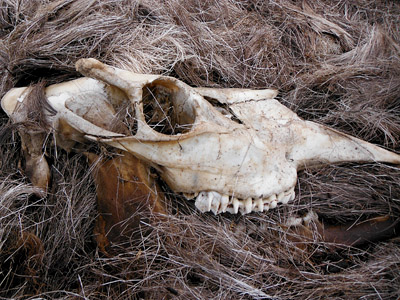
Further Resources:
The following books and website are good resources for more information on recognizing moose habitat via their tracks and sign.
Elbroch 2003. Elbroch & Rinehart 2011. Moskowitz 2010. Whitaker 1997.
http://www.aquatic.uoguelph.ca/
Related Courses:
Wildlife Tracking Courses at Alderleaf
By the way, when you're out tracking or looking for wild animals, it's important to know how to stay safe in the outdoors, especially if you were to get lost. Right now you can get a free copy of our mini survival guide here, where you'll discover six key strategies for outdoor emergencies, plus often-overlooked survival tips.

About the Author: Michelle Peziol is a Wildlife Track & Sign Evaluator with CyberTracker Conservation. She wrote articles while teaching at Alderleaf. Learn more about Michelle Peziol.
Return from Moose Habitat back to Wildlife Tracking Articles
Is The Essential Wilderness Survival Skills Course Right for You? Take the "Online Survival Training Readiness" Quiz
See for yourself if this eye-opening course is a good fit for you. It takes just a few minutes! Get your Survival Training Readiness Score Now!

Grow Your Outdoor Skills! Get monthly updates on new wilderness skills, upcoming courses, and special opportunities. Join the free Alderleaf eNews and as a welcome gift you'll get a copy of our Mini Survival Guide.

 The Six Keys to Survival: Get a free copy of our survival mini-guide and monthly tips!
The Six Keys to Survival: Get a free copy of our survival mini-guide and monthly tips!
Learn more